Emergency Operations: Loyola University Medical Center Upgrades Stormwater Mitigation System After Dangerous Flooding Event

By Bill Wood, P.E.
The year 2013 typically isn’t remembered for its storms. There were no Hurricane Harveys or Marias, no Superstorm Sandys, and no Katrinas. However, while not given names, smaller storms still can severely impact communities and cause major damage and disruption at local and regional levels. This was the type of storm that hit the Loyola University Medical Center (LUMC) Campus in Maywood, Ill., just west of downtown Chicago, in April 2013.
On the heels of weeklong intermittent storms and an overall wet start to spring, 5.55 inches of rain fell in greater Chicago over a two-day span. Although no rainfall records were broken, the region experienced historic flooding, particularly within the Des Plaines River watershed where Loyola’s Medical Center Campus resides. The flood was unprecedented for the Medical Center Campus in its severity and magnitude. Critical hospital, patient care and research facilities took on water, and the state highway that provides primary access to the hospital was impassable for more than two days.
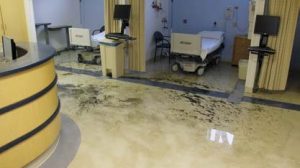
Photos show a flooded patient area in Loyola University Medical Center’s diagnostic imaging section as well as flooding along 1st Avenue (State Route 171, left).

This was the key moment that prompted Loyola to address its growing vulnerability and manage its campus flood risk. According to Kana Henning, associate vice president for facilities at Loyola University Chicago (LUC), “As the region’s Level One Trauma Center, our community depends on our ability to serve the region during an area-wide emergency. We had to develop a comprehensive stormwater management plan to ensure that our facilities are always available to the community we serve. At our Lake Shore Campus in north Chicago, we had implemented a successful stormwater management strategy, and we knew we could replicate those successes at our Medical Center.”
The resulting planning and design process provides an informative case study for flood mitigation, highlighting the importance of resilient thinking, broad-based collaborative partnerships, and high-tech scenario modeling to address the challenges and complexities of urban stormwater management.
Linking Campus and Community Resilience
LUMC, operated by Loyola University Health System (LUHS), is home to essential patient-care facilities, including a 559-bed hospital, cancer center, children’s hospital and burn center serving three counties in Northeast Illinois. Co-located with LUMC on the 61-acre campus is LUC’s Health Sciences Division for medical education, practice and research.
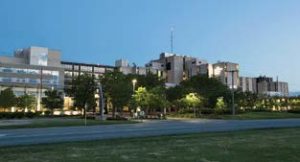
Loyola University Medical Center Hospital has nearly 50,000 emergency-room visits and performs more than 8,000 surgeries annually.
As the Regional Healthcare Coordinating Center, it’s imperative that LUMC facilities are fully operational as an integral part of the region’s homeland-security and emergency-response contingency plan. “Any occurrence that disrupts hospital functions or prevents access to the hospital jeopardizes the public health and safety of not only the immediate area, but the entire Chicago region,” notes Phillip Hale, vice president of government affairs for LUC.
The 2013 flood brought to light the need to safeguard the hospital and its operations through improvements to its supporting infrastructure. It was clearly about more than just managing stormwater onsite; it was about mitigating LUMC’s larger flood risk and vulnerability. At its core, this project was about improving the hospital’s regional resiliency as well as its capacity to serve and provide for the public’s health and welfare during disruptive storm events.
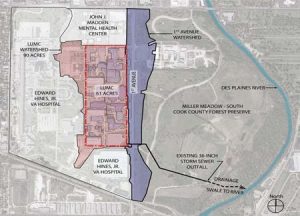
A figure shows the comprehensive watershed analysis extended beyond the LUMC campus to its adjacent neighbors.
SmithGroup has a 30-year working relationship with Loyola, including comprehensive stormwater management planning and design for the university’s Lake Shore Campus. When Loyola asked SmithGroup to study the Medical Center Campus flooding, it was important to take a similarly comprehensive approach to the problem. Water isn’t bound by property lines as it seeks its own level during a storm event; analysis and outreach had to go beyond LUMC’s property lines. Analyzing the entire watershed, engaging institutional neighbors, and collaborating with jurisdictional authorities and stakeholders were essential for the project to succeed.
Building Flood-Mitigation Partnerships
In 2011, LUHS and LUC strengthened their partnership at the Medical Center Campus. “Loyola University had just sold the hospital to Trinity Health, and new protocols and collaborative decision-making models were still being developed at the time of the flood,” notes Hale. This included a reorganization of the Medical Center Campus itself: LUC’s Health Sciences Division occupied the center of the campus, flanked north and south by LUHS facilities.
When asked about the recovery strategy, Hale says, “Water floods without regard to administrative or political boundaries. So before noon on the first day of the 2013 flooding, Loyola Hospital and Loyola University began to work together to address the damage and lay the groundwork for joint mitigation efforts.”
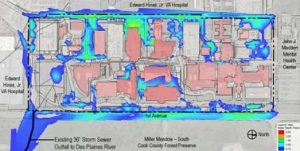
SWMM software simulated the April 2013 flood.
Fronting the LUMC Campus to the east is 1st Avenue, a five-lane highway operated by the Illinois Department of Transportation (IDOT) and serving as the primary access route to the Medical Center for patients, staff and emergency vehicles. The flooding experienced along 1st Avenue, and the impact it had on multiple properties and jurisdictional stakeholders, provided an opportunity to address LUMC’s issues at a larger, more-impactful scale.
The approach was to meet with multiple agencies from the start, not only as a means of discovery, but to build supportive, collaborative partnerships. The Medical Center campus being in unincorporated Cook County required seeking partners beyond city and township levels. Hosted at the Medical Center campus, an introductory meeting with IDOT, other regional agencies and the Metropolitan Water Reclamation District (MWRD) of Greater Chicago, the regional stormwater and wastewater treatment authority for Cook County, laid a foundation for addressing 1st Avenue’s future flood risk at a multijurisdictional scale.
1st Avenue had experienced less-severe flooding prior to 2013; although IDOT had recognized the need to upgrade 1st Avenue’s drainage system, it lacked funds to do so. This is where the joint-agency forum proved particularly beneficial. MWRD also had prioritized 1st Avenue, and it could contribute funds from its community-based program to help with the local flooding issues. To date, MWRD has completed preliminary engineering design with IDOT’s coordination and oversight, and final engineering design is anticipated to soon move forward.
Illinois is known for its flat terrain, and the Medical Center Campus is no different, with only 2-3 feet of elevation change across its 61 acres. As a result, there aren’t sufficient surface overflows away from buildings should floodwaters rise. This issue is compounded by the hospital and other campus facilities having basements with sump-pump systems that are unable to discharge when the river is at flood stage. Creating an emergency overflow outlet for the Medical Center was an essential line of defense against flooding.
This is another area where the collaborative approach showed its strength. Although a pump station had been conceptually identified by SmithGroup as an effective and integral component of an overall mitigation strategy, it was unclear where it could discharge. Working with IDOT and MWRD, the 1st Avenue drainage system became the answer. The agencies agreed to upsize the storm sewer in addition to the highway’s own drainage upgrades they were designing. Thanks to early dialog and collaboration, IDOT and MWRD have been valued partners in tackling hospital access issues as well as overall flood-mitigation solutions for the entire campus.
In addition to accounting for downstream impacts of drainage and discharge, SmithGroup also had to evaluate what was happening upstream to complete a full watershed analysis. Together with the Edward Hines Jr. Veterans Administration (VA) Hospital to the west and south, and John Madden Mental Health to the north, LUMC and these two other institutions form an ad hoc medical district for the surrounding community. The project’s initial discovery meetings were used to determine if these institutions’ stormwater drainage infrastructure was interconnected with LUMC’s infrastructure and potentially influencing each other.
The resulting process revealed that the Hines VA Hospital and LUMC storm drainage systems were intertwined through sewers dating back to the 1940s. As a result, the study area needed to expand westward to include approximately 29 acres of the Hines VA Hospital property. The Madden Mental Health Center’s drainage system, however, was determined to be separate from LUMC’s infrastructure, despite the two institutions sharing some parking facilities. Without this understanding of the entire watershed upstream of the Medical Center, stormwater modelling and analysis would have incorrectly simulated the real-life flood conditions and potential solutions.
Modeling Scenarios to Better Understand and Manage Risks
Although the 2013 flood was disruptive and dangerous for LUMC, the fact that the storm that caused it was not a historic event made it even more troubling. Shorter, more-intense storms that don’t meet the official criteria of 100- or 500-year events can quickly overwhelm stormwater infrastructure and be just as damaging; these types of flashy rain events also are becoming more common. The pressing need for LUMC was to identify a flood-mitigation solution that could handle this wider range of storm intensities and durations.
To accomplish this, SmithGroup modeled and analyzed the expanded watershed and existing infrastructure using XP-SWMM, dynamic hydrologic and hydraulic modeling software developed by XPSolutions. SWMM stands for Storm Water Management Model, and it allows engineers to simulate various storm parameters and potential mitigation solutions.
Using the Hydraulics module, stormwater runoff hydrographs were routed through the modeled storm-sewer system to check pipe flows against existing capacities. This digital pipe network was linked to campus building footprints and surface terrain to create a fully interactive, 3D model of the current system, which was calibrated with historic flood data. When this modeled storm-sewer system surcharged, the volume, depth and behavior of floodwaters were visualized and plotted on the surface as well as within the pipe network.
The resulting model was able to simulate flooding along 1st Avenue and the hospital access drives for various storm intensities and durations, including the April 2013 event with the river at its measured flood stage. The results identified the conveyance issues that needed to be addressed during peak storms and various river flood stages.
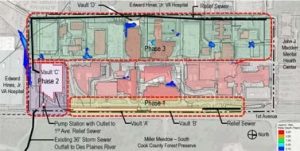
A Flood Mitigation Plan with modeled performance for a 50-year storm event shows 1st Avenue and campus drives clear. Localized ponding will be addressed with minor branch sewer upgrades.
With baseline conditions established, the process turned to evaluating potential solutions. Performance was consistently modeled at a campus/watershed scale, rather than for individual buildings or subareas. This scaled-up approach was crucial; it allowed new infrastructure to be strategically placed, evaluated and “right-sized,” maximizing the performance benefits for a campus with limited space due its substantial building coverage. It’s important to note that the most-impactful solutions frequently exceeded regulatory requirements, exemplifying the measurable gap between meeting minimum standards and providing true flood resilience for the campus.
A key challenge for LUMC campus stormwater management was the limited ability to utilize green infrastructure (GI) as part of the design solution. GI features such as permeable pavements, rain gardens and greenroofs can help reduce generated runoff by promoting infiltration, providing storage and slowing release rates. SmithGroup used GI extensively as part of a campus-wide stormwater management strategy for Loyola’s Lake Shore Campus and looked to employ similar practices at the Medical Center Campus. However, the poorly draining, heavy clay soils at the LUMC campus severely limited the effectiveness of surface-level GI, while the existing buildings could not be cost-effectively retrofitted with greenroofs.
After evaluating numerous alternatives, the design team identified a series of detention storage vaults and relief sewers as the optimal solution for mitigating campus flood risk. Four vaults, comprised of modular precast concrete units manufactured by StormTrap, provide 8.9 acre-feet of stormwater detention storage. The vaults are strategically placed underneath the surface parking lots identified as the last remaining spaces not slated for future development. StormTrap’s highly efficient system was essential to maximize the vaults’ storage capacity within these constrained footprints. The units’ ability to support H-20 loads with minimal cover further increased storage, critical for overall performance.
Approximately 900 lineal feet of relief sewer, using elliptical pipe as large as 38 by 60 inches, supplements the existing sewer network on the west and south perimeters of campus where vaults were not feasible. The pump station required to discharge the overflow to the upgraded sewer along 1st Avenue is positioned at the downstream end of the integrated campus network. Coupled with the pump station is a hydrodynamic separator to improve water quality as stormwater is discharged from the mainline and overflow systems.
The Flood Mitigation Plan’s three-phase implementation strategy was carefully crafted to meet the project’s resilience objectives and fiscal realities. Because safeguarding the hospital and patient care facilities on the east side of campus and ensuring uninterrupted access to them was the top priority, the two detention vaults and a relief sewer along the east edge of campus became Phase 1. Phase 2 was aligned with IDOT and MWRD’s schedule for the 1st Avenue Drainage Improvements; this phase includes pump-station coordination, a water-quality treatment structure at the downstream end of the campus system, and a 5.9-acre-foot vault within the southeast parking lot. Phase 3 calls for new relief sewer on the west and south sides of campus as well as a storage vault within a small parking lot. The fully implemented, $23.5 million plan optimizes drainage performance across the entire campus, anticipating and accounting for a wide range of potential storm and flood conditions.
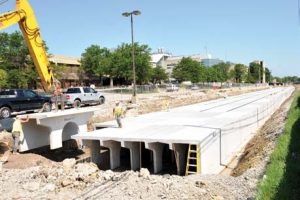
The Phase 1 StormTrap stormwater detention vault was installed adjacent to 1st Avenue, which is the primary access to LUMC.

Continued Collaboration Through Funding and Construction
The need for partnerships didn’t end with completion of the mitigation plan. One more partner, the Cook County Bureau of Economic Development, was instrumental in getting construction started.
While the flood-mitigation plan was being developed in 2014, LUHS and LUC began a campaign to fund final design and implementation of the infrastructure. The co-owners engaged multiple agencies, officials and legislators in search of potential funding early in the process, forging key partnerships with Cook County. As a direct result of the April 2013 flood, Cook County was appropriated disaster relief funds by the U.S. Department of Housing and Urban Development (HUD). The county administers available funds to affected community members through its Community Development Block Grant (CDBG) Program. From homeowners to institutions, funds are distributed by the county based on need.
Through early engagement, Loyola gained the support of six Cook County Commissioners, members of the Illinois General Assembly representing LUMC, four members of the U.S. House of Representatives, and both U.S. Senators from the State of Illinois. In addition, Cook County’s Department of Homeland Security recognized that flooding to a Level One Trauma Center such as Loyola constituted a significant public safety and security risk.
With this assessment and universal support from elected officials, LUHS and LUC put forth a joint flood-mitigation proposal to the Bureau of Economic Development. In 2016, the Bureau granted $5.5 million in funds for Phase 1. LUHS and LUC have contributed matching dollars as well. Final design of Phase 1 began later the same year and was completed in mid-2017. Phase 1 construction is on schedule to be completed in fall 2018. The project team continues to pursue funds to complete Phases 2 and 3, utilizing the same collaborative approach.
Conclusion
The challenges posed by urban flooding have become more multilayered and interconnected than ever before. Aging infrastructure, growing density and a changing climate have come together to create problems that site-specific best-management practices and project-specific regulatory standards can’t adequately solve.
Urban flood mitigation increasingly requires a resilient and holistic design approach, leveraging a broad range of collaborative thinking and partnerships to achieve the best results. By scaling up their stormwater-management thinking to neighborhood and regional watershed levels, municipalities and institutions will be better able to anticipate and manage the higher levels of flood risk they’re facing. Site-specific improvements implementing a district-scale performance strategy as well as sharing responsibilities and costs for flood-risk management across jurisdictional lines benefit the community as a whole.
The process and outcomes at the Loyola University Medical Center provide a highly relevant and effective example of how this can be done, which was recognized by MWRD President Mariyana Spyropoulos.
“We commend Loyola University Medical Center for making the crucial investments that will help build a resilient Chicago area in the face of increasing intense rain events and stormwater saturation,” says Spyropoulos. “The MWRD builds infrastructure projects to address flooding solutions and partners with local communities and agencies like IDOT to address stormwater management because we realize we cannot accomplish this enormous task alone. That’s why it is encouraging to hear how Loyola is striving to elevate the importance of both gray and green infrastructure and improve the community as a whole.”
About Bill Wood
Bill Wood, P.E. and Associate, has been a civil engineer at SmithGroup for 20 years, serving as the Chicago office’s Discipline Lead since 2004; email: [email protected].


